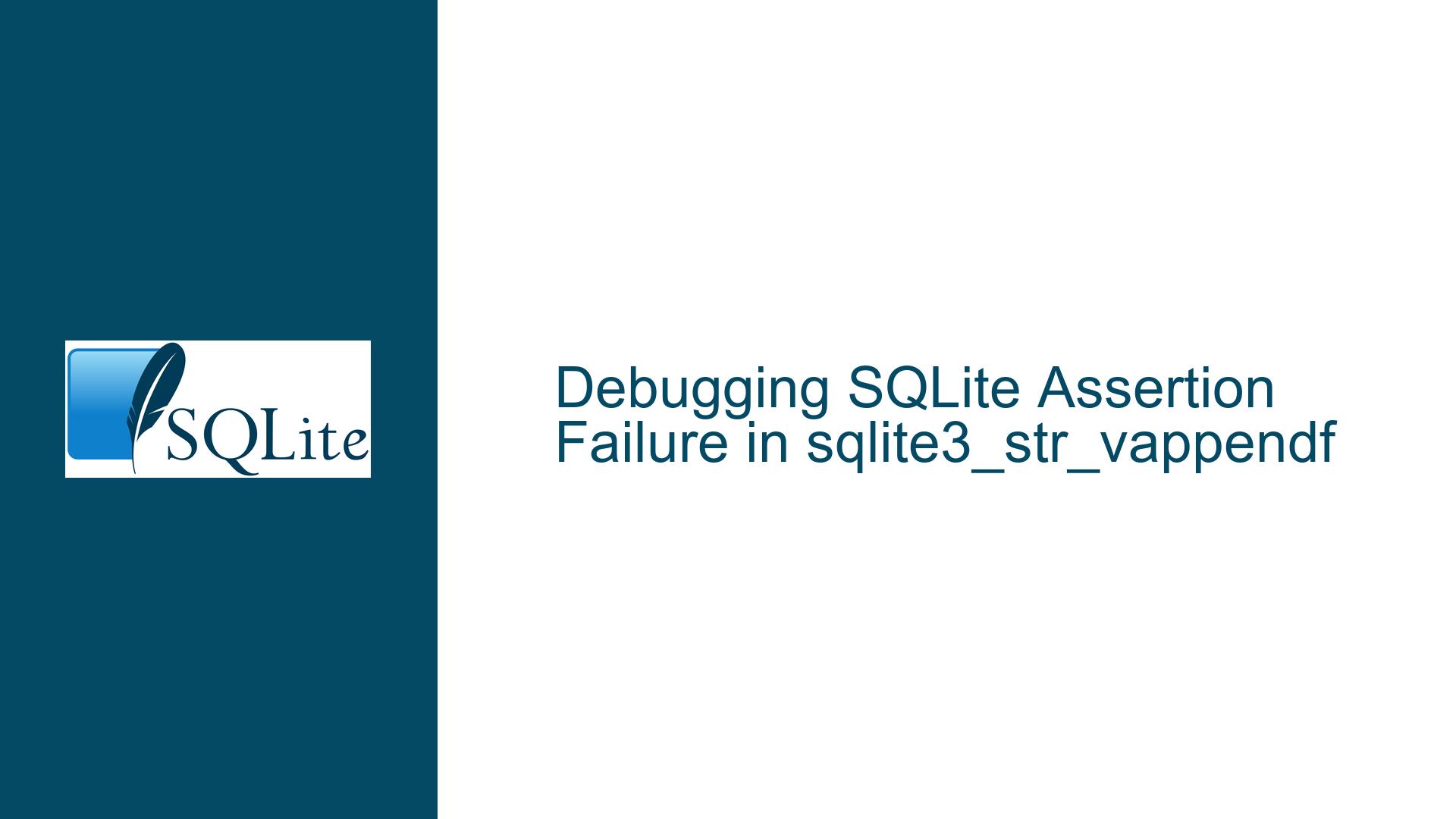Debugging SQLite Assertion Failure in sqlite3_str_vappendf
Issue Overview: Assertion Failure in sqlite3_str_vappendf Due to Unreachable Code Path
The core issue revolves around an assertion failure in the SQLite source code, specifically within the sqlite3_str_vappendf function. This failure occurs when a modified version of the SQLite source code is executed, where a custom line has been inserted into the sqlite3WalkSelect function to call sqlite3TreeViewSelect(0, p, 0) at each pass. The assertion failure is triggered by the ALWAYS macro, which is designed to catch coding errors by ensuring that certain conditions are always true. When the modified code causes an otherwise unreachable branch to be taken, the assertion fails, resulting in an abort.
The problem manifests when executing a query that involves subqueries, such as SELECT x FROM (SELECT x FROM t). The sqlite3TreeViewSelect function is used to generate a tree-like representation of the query structure, which is useful for debugging and understanding the internal workings of SQLite. However, the insertion of this function call disrupts the normal flow of execution, leading to the assertion failure.
The assertion failure occurs at lines 29910-29911 in the sqlite3_str_vappendf function, where the code checks if pItem->pSelect is non-null using the ALWAYS macro. The ALWAYS macro is a debugging aid that ensures the condition is always true, and if it is not, the program aborts. In this case, the modified code causes the condition to be false, triggering the assertion failure.
Possible Causes: Unintended Side Effects of Modifying sqlite3WalkSelect
The primary cause of the issue is the insertion of the sqlite3TreeViewSelect(0, p, 0) call within the sqlite3WalkSelect function. This modification alters the execution flow of the SQLite code, causing an otherwise unreachable code path to be taken. The ALWAYS macro is designed to catch such situations, as they often indicate subtle coding errors or unexpected behavior.
The sqlite3WalkSelect function is part of SQLite’s internal query processing machinery, and it is responsible for traversing the abstract syntax tree (AST) of a SQL query. By inserting a call to sqlite3TreeViewSelect, the original poster (OP) is attempting to visualize the query structure at each step of the traversal. However, this modification inadvertently affects the state of the query processing, leading to the assertion failure.
Another potential cause is the interaction between the sqlite3TreeViewSelect function and the sqlite3_str_vappendf function. The sqlite3_str_vappendf function is used to format and append strings, and it is called by sqlite3TreeViewSelect to generate the tree-like representation of the query. The assertion failure suggests that the sqlite3TreeViewSelect function is being called in a context where the pItem->pSelect pointer is unexpectedly null, which violates the assumption enforced by the ALWAYS macro.
Troubleshooting Steps, Solutions & Fixes: Resolving the Assertion Failure and Ensuring Proper Query Visualization
To resolve the assertion failure and ensure that the query visualization works as intended, several steps can be taken. The first step is to remove the ALWAYS macro from the sqlite3_str_vappendf function, as suggested by Richard Hipp. This change allows the code to proceed even if the pItem->pSelect pointer is null, preventing the assertion failure. The modified code should look like this:
} else if (pItem->pSelect) {
sqlite3_str_appendf(pAccum, "SUBQUERY %u", pItem->pSelect->selId);
}
However, this is only a partial solution, as it does not address the root cause of the issue. The next step is to determine the appropriate location to call sqlite3TreeViewSelect so that it does not interfere with the normal execution flow of the SQLite code. One potential location is the sqlite3ResolveSelectNames function, which is responsible for resolving column names and other identifiers in a SQL query. By calling sqlite3TreeViewSelect at the end of this function, it is possible to visualize the query structure after all names have been resolved, without disrupting the query processing.
To implement this solution, the following changes can be made to the SQLite source code:
Remove the
sqlite3TreeViewSelectcall fromsqlite3WalkSelect: This ensures that the normal execution flow of the query processing is not disrupted.Add a call to
sqlite3TreeViewSelectinsqlite3ResolveSelectNames: This allows the query structure to be visualized after all names have been resolved, providing a more accurate representation of the query.
The modified code for sqlite3ResolveSelectNames might look like this:
void sqlite3ResolveSelectNames(
Parse *pParse, /* The parser context */
Select *pSelect, /* The SELECT statement to be processed */
NameContext *pOuter /* Name context for the parent SELECT */
) {
// Existing code to resolve select names...
// Call sqlite3TreeViewSelect to visualize the query structure
sqlite3TreeViewSelect(0, pSelect, 0);
}
By making these changes, the query visualization will be generated at a point in the query processing where the query structure is fully resolved, and the assertion failure will be avoided. This approach ensures that the visualization is accurate and does not interfere with the normal operation of SQLite.
In addition to these changes, it is important to thoroughly test the modified code to ensure that it behaves as expected in all scenarios. This includes testing with various types of queries, including those with subqueries, joins, and complex expressions. It is also important to verify that the query visualization is generated correctly and that it provides useful information for debugging and understanding the query structure.
Finally, it is worth considering whether the sqlite3TreeViewSelect function is the best tool for the task at hand. While it provides a detailed tree-like representation of the query structure, it may not be the most efficient or user-friendly way to visualize queries, especially for large or complex queries. Alternative approaches, such as using a graphical query plan visualization tool or generating a more concise textual representation of the query structure, may be more suitable in some cases.
In conclusion, the assertion failure in sqlite3_str_vappendf is caused by an unintended side effect of modifying the sqlite3WalkSelect function to call sqlite3TreeViewSelect. By removing the ALWAYS macro and relocating the sqlite3TreeViewSelect call to a more appropriate location, such as sqlite3ResolveSelectNames, the issue can be resolved, and the query visualization can be generated without disrupting the normal operation of SQLite. Thorough testing and consideration of alternative visualization methods are also important steps in ensuring the success of this solution.






